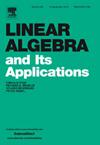Pareto singular values of Boolean matrices and analysis of bipartite graphs
IF 1
3区 数学
Q1 MATHEMATICS
引用次数: 0
Abstract
The complementarity eigenvalues of a graph , which are defined as the Pareto eigenvalues of the adjacency matrix , provide a rich information on structural properties of the graph. Complementarity eigenvalues are of special relevance for connected graphs. For instance, it has been conjectured that the complementarity eigenvalues of a connected graph determine the graph up to isomorphism. Analogously, the Pareto singular values of the biadjacency matrix of a connected bipartite graph reflect various structural properties of the bipartite graph under consideration. The theory of Pareto singular values of general matrices was initiated in our paper entitled Cone-constrained singular value problems published in the Journal of Convex Analysis (30, 2023, pp. 1285-1306). In this work we explore various aspects of such a theory, paying special attention to Pareto singular values of Boolean matrices and their role in the analysis of bipartite graphs.
求助全文
约1分钟内获得全文
求助全文
来源期刊
CiteScore
2.20
自引率
9.10%
发文量
333
审稿时长
13.8 months
期刊介绍:
Linear Algebra and its Applications publishes articles that contribute new information or new insights to matrix theory and finite dimensional linear algebra in their algebraic, arithmetic, combinatorial, geometric, or numerical aspects. It also publishes articles that give significant applications of matrix theory or linear algebra to other branches of mathematics and to other sciences. Articles that provide new information or perspectives on the historical development of matrix theory and linear algebra are also welcome. Expository articles which can serve as an introduction to a subject for workers in related areas and which bring one to the frontiers of research are encouraged. Reviews of books are published occasionally as are conference reports that provide an historical record of major meetings on matrix theory and linear algebra.

 求助内容:
求助内容: 应助结果提醒方式:
应助结果提醒方式:


